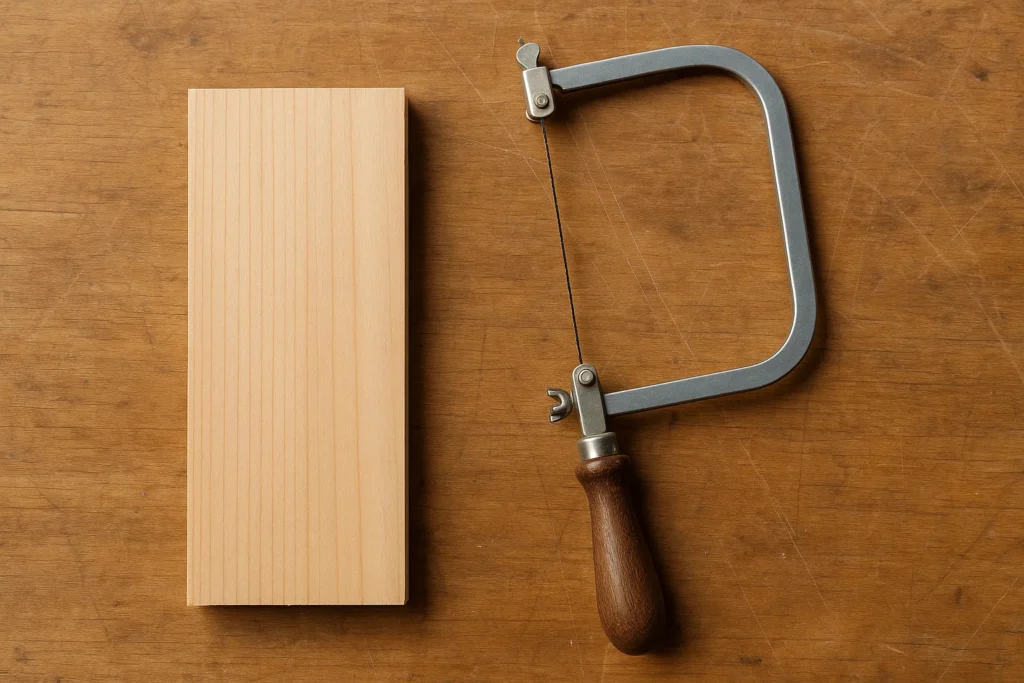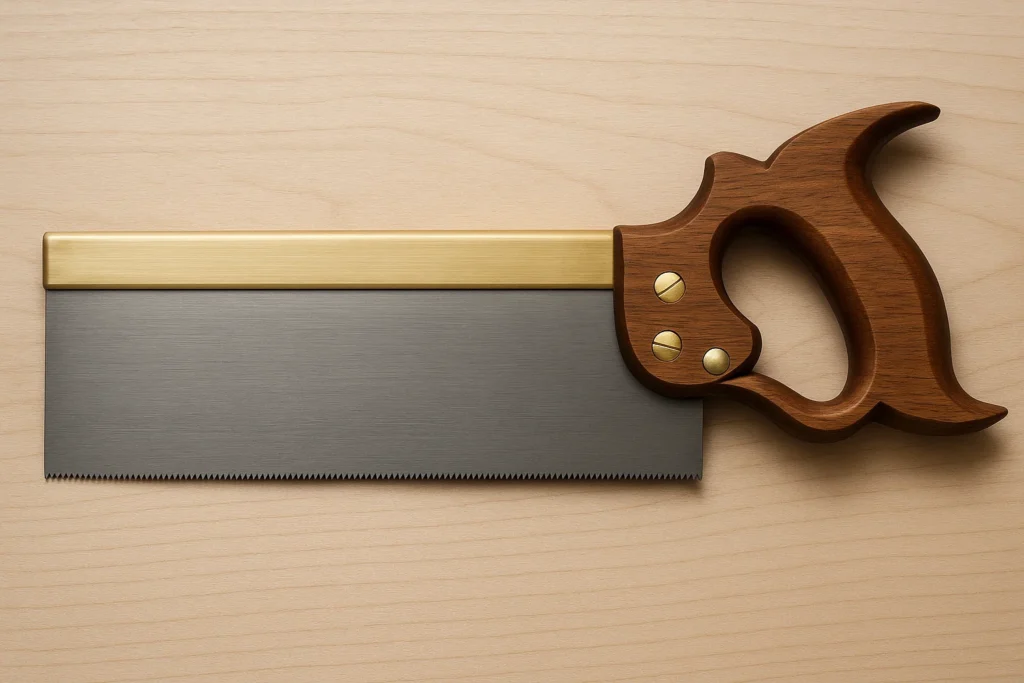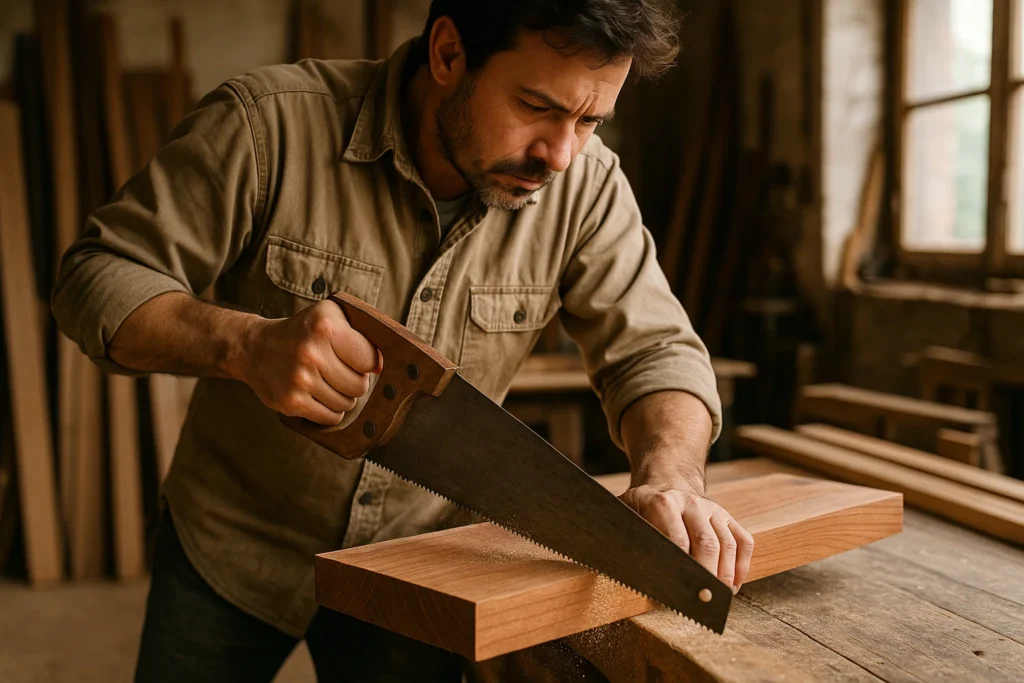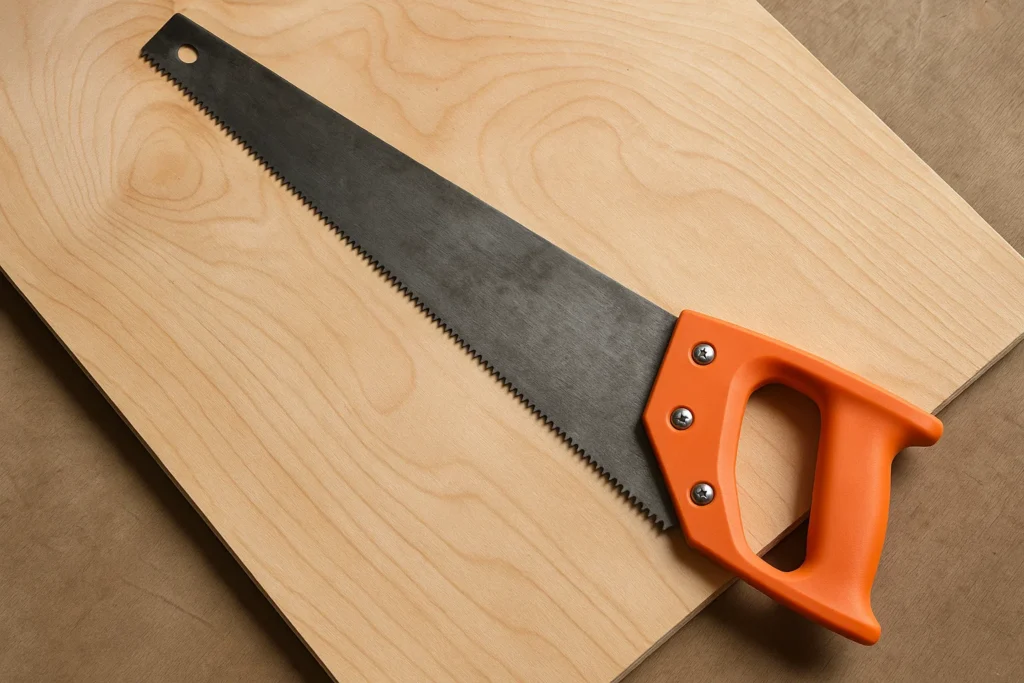This lightweight fret saw offers fast tensioning, ambidextrous setup, and precise curved cuts for frequent users. Its premium price and minor clamp quirks may deter casual hobbyists.
It Isn’t Just About Finding Any Blade
Choosing the right hand saw for curved cuts isn’t just about finding any blade, it’s about balancing precision, control, and durability.
Pick a saw with the right blade width and tooth pattern to avoid binding or splintering, and make sure the handle and tension system give you comfort and accuracy without forcing or breaking the blade.
Whether you need tight scrollwork, smooth arches, or internal plunge cuts, understanding these trade‑offs will help you avoid wasted material, wasted time, and costly tool failures.
Important Points
- Narrow blades (under 1/8″) turn tighter curves.
- Aim for 15–20 TPI for smooth, controlled cuts.
- Balance blade flex with rigidity to prevent wandering.
- Comfortable, close‑to‑blade handles improve control.
- Proper blade tension prevents binding or breakage.
- Match saw type to curve: fret, coping, bow, keyhole, or pull.
- Drill starter holes for clean internal plunge cuts.
- Use light, steady strokes, let the blade cut itself.
- Pivot the workpiece, not the saw, for smoother arcs.
- Practice on scrap before cutting the real piece.
Some or all Images are generated by AI for illustration.
Best Hand Saws For Curved Cuts
Hand Saws | Best For | Saw Type | TPI |
|---|---|---|---|
Manual fret saw | 15 TPI | ||
Coping Saw | 15 TPI | ||
Japanese Pull Saw | 17 Teeth, 20 Teeth | ||
Coping Saw | 17 TPI | ||
Razor Saw | 42 TPI |
Note: We don’t test products ourselves. Instead, we go through user reviews and/or community discussions to find and recommend the best options.
1. Knew Concepts Fret Saw
This lightweight fret saw offers fast tensioning, ambidextrous setup, and precise curved cuts for frequent users. Its premium price and minor clamp quirks may deter casual hobbyists.
Key Features
- Blade Length: 5 in (12.7 cm) blade fits tight curves and larger fret work in dovetails.
- TPI: 15 TPI (#7 skip‑tooth) cuts waste quickly without clogging.
- Blade Material: High Speed Steel offers long‑lasting sharpness and toughness.
- Handle Type and Material: Straight wooden handle
- Saw Type: Manual fret saw with truss‑style frame for precise curved cuts.
- Replaceable or Fixed Blade: Replaceable blade with quick‑change holder and cam tensioner.
Pros & Cons
Pros:
- Ambidextrous Setup: Can be quickly configured for left- or right‑handed use, letting all woodworkers cut curves without awkward repositioning.
- Rapid Tensioning: Cam‑lever mechanism tensions the blade in seconds, so you spend less time adjusting and more on cutting.
- Lightweight Frame: At about 5.2 oz, the truss‑style frame reduces hand fatigue during intricate curved cuts.
- Precise Turning: Thin blades and tight detents enable smooth, accurate 45° pivots for tight curves in dovetails.
- Easy Blade Changes: Thumb‑screw clamps and a unique holder let you swap blades in moments, improving workflow.
- Durable Cuts: High‑rigidity frame and blade holder design minimize breakage and extend blade life.
Cons:
- High Price: Premium cost may feel steep compared to basic coping saws for occasional curved cuts.
- Clamp Slippage: Blade clamps can loosen or slip under tension without a factory fix, requiring user adjustment.
- Small Handle: Handle diameter is narrow, which some users find uncomfortable during extended use.
- Finish Wear: Red coating can scratch or scrape off easily, affecting the tool’s appearance over time.
- Thin Frame: Some report the lightweight aluminum bends under heavy force, reducing stability.
Note: These pros and cons are based on user review trends and latent consensus.
Our Verdict
A versatile fret saw that excels at curved cuts.
Buy If:
- You need ambidextrous setup for left‑ or right‑handed work.
- You value rapid blade tensioning for efficient workflow.
- You want a lightweight frame to reduce hand fatigue.
- You require precise 45° pivots for tight curve control.
Don’t Buy If:
- You’re on a tight budget and can’t justify a premium price.
- You need a large, cushioned handle for extended use.
- You can’t tolerate occasional clamp slippage under tension.
- You require a scratch‑resistant finish for heavy shop use.
Overall, this Knew Concepts fret saw is ideal for tradespeople and DIYers who prioritize speed, precision, and ambidextrous use in curved cuts. Its premium build and rapid adjustments justify the cost for frequent users, but occasional hobbyists may find its price and minor clamp quirks a drawback.
2. JORGENSEN Pro Coping Saw
A robust, precision coping saw with a sturdy tubular frame, ergonomic grip, and spare blade for uninterrupted scroll work, ideal for detailed curves, though blade changes can be stiff.
Key Features
- Blade Length: 6‑1/2 in (16.5 cm), deep enough to cut through wider boards
- TPI: 15 TPI, delivers fast, precise cuts in wood and plastic
- Blade Material: High‑speed steel, stays sharp for clean, accurate curves
- Handle Type and Material: Ergonomic grip, plastic, comfortable hold that won’t slip
- Saw Type: Coping saw, designed for curved and intricate cuts
- Replaceable or Fixed Blade: Replaceable blades, swap dull blades quickly without extra tools
Pros & Cons
Pros:
- Solid Stability: Tubular frame delivers minimal vibration, ensuring smooth, controlled curved cuts without deflection.
- Precision Cutting: Sharp HSS blades and secure tension hold provide accurate, consistent scroll work for intricate curves.
- Secure Grip: Ergonomic, non-slip handle lets you guide curves confidently for extended sessions without hand fatigue.
- Quick Spare: Includes an extra blade so you can resume detailed cutting immediately when one blade dulls.
- Versatile Use: Light-weight design excels on small woodworking, molding, and plastic curves where larger saws can’t reach.
Cons:
- Blade Replacement: High tension makes swapping blades difficult—often requiring a clamp or two-person effort to compress the frame.
- Spare Quantity: Contrary to some descriptions, only one extra blade is in the package, limiting immediate backup options.
- Blade Durability: Occasional reports of blades breaking on first use suggest inconsistent blade toughness for tough curves.
- Heavy-Duty Limits: Frame may flex under aggressive angle cuts on thick molding, reducing precision on very rigid stock.
Note: These pros and cons are based on user review trends and latent consensus.
Our Verdict
A sturdy, precise coping saw that shines on detailed curved work.
Buy If:
- You need a rigid frame for smooth, vibration‑free curved cuts.
- You tackle intricate scroll work in wood, plastic, or light metal.
- You value an ergonomic, non‑slip grip for steady control.
- You appreciate having an extra blade on hand for uninterrupted work.
Don’t Buy If:
- You dread wrestling with high‑tension blade changes each time.
- You expect more than a single spare blade included.
- You plan heavy‑duty angled cuts on thick molding where flex is a concern.
Overall, the Jorgensen Pro Coping Saw is a top pick for DIYers and tradespeople focused on precision curves, offering excellent stability and comfort. Just be ready for a bit of effort when swapping blades and pack an extra blade if you need backups.
3. Temple Tool Co.
This Japanese flush‑cut pull saw offers precise, tear‑free curved cuts and a lightweight design for detailed work. Expect clean results with light sanding and a slightly slower feed in very dense woods.
Key Features
- Blade Length: 6 in (15.2 cm) blade for cutting flush in tight spots
- TPI: 17 teeth for hardwood, 20 teeth for softwood
- Blade Material: High carbon steel for long-lasting sharpness
- Handle Type and Material: Solid beech wood handle with brass fittings for a firm, durable grip
- Saw Type: Japanese flush cut pull saw for precise, narrow-kerf cuts
- Replaceable or Fixed Blade: Replaceable blade
Pros & Cons
Pros:
- Razor Sharp: Ultra-thin, narrow-kerf blade delivers exceptionally clean pull‑stroke cuts, reducing tear‑out on delicate curved work.
- Low Binding: Precision‑sharpened teeth follow the cut line smoothly, minimizing blade buckle and making curved trims effortless.
- Dual‑Sided: Double‑edged design lets you approach flush cuts from either side, boosting flexibility in tight or awkward curves.
- Lightweight: Balanced, slim profile and solid beech handle reduce hand fatigue during detailed or extended curved cuts.
- Fine Finish: Delivers near–scratch‑free results on hardwoods, ideal for visible curved surfaces without additional touch‑up.
Cons:
- Minimal Sanding: Leaves a slight burr on dowels and wedges, requiring light sanding for a perfectly flush finish.
- Slower Feed: Lack of tooth set can slow cutting when tackling denser wood protrusions, prolonging curved‑cut tasks.
Note: These pros and cons are based on user review trends and latent consensus.
Our Verdict
This saw excels at precise, tear‑free curved flush cuts.
Buy If:
- You need razor‑sharp pull‑stroke cuts on delicate curved surfaces.
- You work in tight spots and benefit from cutting from either blade side.
- You want a lightweight tool that reduces hand fatigue during detailed curves.
Don’t Buy If:
- You expect a perfectly burr‑free finish without any sanding.
- You often tackle very dense hardwoods that require faster cutting.
- You need aggressive stock removal on thick protrusions.
Overall, this Japanese flush‑cut pull saw is a top choice for DIYers and tradespeople focused on clean, controlled curved cuts. It shines in detailed work but may slow you down on harder woods and require a bit of finishing.
4. IRWIN Coping Saw
The IRWIN ProTouch Coping Saw offers a comfy grip and easy blade swaps for clean curved cuts at a budget price. Some units may need inspection for pin alignment before use.
Key Features
- Blade Length: 6-1/2 in (16.5 cm), fits most frame depths for detailed work.
- TPI: 17 teeth per inch, fine teeth for precise curved cuts.
- Blade Material: High-speed steel, durable and cuts through most materials with ease.
- Handle Type and Material: Ergonomic triangular ProTouch handle for comfort during extended use.
- Saw Type: Coping saw, designed for curved and intricate cuts.
- Replaceable or Fixed Blade: Replaceable blade secured with DuraSteel pins for quick blade changes.
Pros & Cons
Pros:
- Affordability: Very low price lets you grab a coping saw for occasional curved cuts without breaking the budget.
- Comfort: Ergonomic ProTouch handle reduces hand fatigue during trim fitting or hobby work.
- Precision: Fine 17 TPI blade cuts smooth curves in wood, vinyl tile, and baseboards.
- EaseOfUse: Simple manual setup makes quick one‑off repairs, like trimming a night guard, a breeze.
- BladeSwap: DuraSteel pins let you replace blades fast for different cutting tasks.
Cons:
- Alignment: Blade‑holding pins often sit at an angle, bending the blade and affecting cut accuracy.
- LooseFasteners: Keeper nut and handle screw can slide or loosen, allowing the blade to twist mid‑cut.
- BladeFragility: Blades may dull faster than expected or snap under moderate pressure.
- QAInconsistency: Some units arrive warped or poorly assembled, leading to returns or in‑store hunts.
- AdjustmentRisk: Trying to straighten a crooked pin can break it, leaving the saw unusable.
Note: These pros and cons are based on user review trends and latent consensus.
Our Verdict
Budget‑friendly choice for DIY curved cuts with solid comfort and precision.
Buy If:
- You need an affordable saw for occasional curved trims.
- You make fine curved cuts in wood or vinyl tile.
- You swap blades often for varied materials.
- You want an ergonomic handle for longer jobs.
Don’t Buy If:
- You require perfect blade alignment for precision work.
- You use a coping saw daily under heavy load.
- You can’t tolerate loose fasteners mid‑cut.
- You expect long blade life without frequent replacements.
This coping saw excels for DIYers on a budget who need comfort and quick blade changes for trim and hobby projects. Tradespeople seeking flawless out‑of‑the‑box alignment or heavy‑duty durability may prefer a higher‑end model.
5. X-ACTO Razor Saw
A slim, precision razor saw set with replaceable blades for clean, tight‑radius cuts in wood, plastic, and soft metals. Ideal for detailed hobby and light‑duty curved cutting tasks.
Key Features
- Blade Length: 4.5 in (11.4 cm) for precise cuts in tight spaces
- TPI: 42 TPI
- Blade Material: Metal for durability and clean, consistent cuts
- Handle Type and Material: Auto‑retractable plastic handle for safe storage and easy handling
- Saw Type: Precision razor saw for detailed model and hobby work
- Replaceable or Fixed Blade: Replaceable blades for quick swapping between fine and medium cuts
Pros & Cons
Pros:
- Fine‑Kerf: Ultra‑thin blade cuts allow precise curved cuts in plastic, wood, or metal without excessive material removal.
- Sharpness: Razor‑sharp teeth maintain clean curves through multiple cuts on varied materials.
- Blade‑Swap: Quick, replaceable blades let you switch between fine and medium cuts for different curve radii.
- Groove‑Fit: Slim profile easily slips into narrow grooves and tight curved profiles for detailed work.
- Durability: Metal blades resist dulling on soft metals and woods, holding edge for extended use.
Cons:
- Blade‑Looseness: Blades often fit loosely in the handle, causing wobble and uneven curves.
- Handle‑Wobble: Plastic chuck can become unstable, reducing control on tight bends.
- Flimsy‑Blade: Thin blades flex or break when forced through sharp curves or harder materials.
- Tracking‑Issue: Uneven tooth offset can cause blade to veer off intended curved path without manual honing.
- Depth‑Limit: Shallow blade depth prevents full cuts in deeper curves or miter‑box slots.
Note: These pros and cons are based on user review trends and latent consensus.
Our Verdict
A solid choice for precise curved cuts in hobby or light‑duty applications.
Buy If:
- You need ultra‑thin kerf for clean, tight-radius curves in wood, plastic, or soft metal.
- You value quick blade swaps to adjust between fine and medium tooth profiles.
- You work on small grooves or recessed curves where a slim blade slips in easily.
Don’t Buy If:
- You require heavy‑duty cutting or deep curves beyond the blade’s shallow depth.
- You need rock‑solid blade stability for long, continuous curved cuts.
- You often cut hard or thick materials that risk flexing or breaking the blade.
This precision razor saw excels at delicate, intricate curved work where minimal material removal matters. Tradespeople tackling tougher jobs or deeper cuts should consider a sturdier coping or fret saw instead.
What Makes a Saw Good for Curved Cuts?

Not every hand saw can handle curves. Curved cuts require control, precision, and the ability to turn smoothly without binding or breaking the blade. Here’s what separates a good curved-cut saw from the rest:
1. Narrow Blade Width
A narrow blade turns more easily. The thinner the blade (side to side), the tighter the curve you can cut.
Wide blades are great for straight lines but will resist turning and may snap or splinter the wood during a curve.
Tip: For tight scrollwork, look for blades under 1/8 inch wide.
2. Tooth Size and Pattern (TPI)
TPI means “teeth per inch.” More teeth give a smoother cut but move slower. Fewer teeth cut faster but rougher.
For curves, aim for fine teeth (around 15–20 TPI). This helps the blade bite gently and follow turns without tearing the material.
3. Blade Flexibility
Some flex helps the blade adjust to the curve without forcing it.
Too stiff, and it won’t turn. Too floppy, and it may bend off track. A good curved-cut saw balances flex with strength.
4. Handle Design
You need control, not power. Look for handles that:
- Let you grip close to the blade
- Allow turning the saw as your hand stays steady
- Feel natural in your hand—comfort equals control
5. Cutting Direction
Some saws cut on the push, others on the pull, and some do both.
- Pull saws give more control on tight turns.
- Push saws need more effort but feel more familiar to many users.
6. Material Compatibility
Not every saw cuts every material well. Make sure your saw is rated for:
- Wood (hard or soft)
- Plastic
- Drywall or soft metals (if needed)
Always check before buying. Using the wrong saw can ruin both the blade and your work.
Types of Hand Saws for Curved Cuts

Different saws are designed for different types of curves. Some are made for tight turns, others for large sweeping shapes.
Knowing the types of hand saws that are actually built for curved cuts will help you choose the right one for your project—not just by name, but by how they perform and when to use them.
1. Coping Saw
Best for: General curved cuts, mid-size turns, joints, and shaping.
A coping saw has a thin, removable blade held under tension in a C-shaped metal frame. The blade is narrow and fine-toothed, making it great for most curve work in wood or plastic.
Key Features:
- Blades can turn while cutting (you rotate the handle)
- Great control, even on tight curves
- Blades are easy to change for different materials
If you’re only getting one saw for curved cuts, a coping saw is usually the most versatile starting point.
2. Fret Saw
Best for: Tight, detailed curves and fine scrollwork.
A fret saw looks like a coping saw but with a deeper frame and an even thinner blade. It’s designed for delicate, precision work—think puzzle pieces, inlays, or intricate wood patterns.
Key Features:
- Extremely fine blade (often 20+ TPI)
- High precision but not great for thick material
- The deep frame lets you cut far from the edge of a board
Use this when the detail matters more than speed or strength.
3. Bow Saw (Curved-Cut Type)
Best for: Larger curves in thicker or rougher materials.
Not all bow saws are for curves. But some versions use a thinner blade that allows for moderate turning, especially when shaping furniture or trimming branches with a curve.
Key Features:
- Bigger frame with replaceable blades
- Designed more for rough curves than fine detail
- Good for shaping large pieces of wood
Think of this as a “bigger cousin” of the coping saw, made for strength over detail.
4. Keyhole Saw (Also called Compass Saw)
Best for: Cutting curved shapes inside a surface (plunge cuts).
A keyhole saw has a long, narrow, pointed blade—like a dagger with teeth. You can insert it into a drilled hole and cut outward in a curve. It’s commonly used in drywall or plywood.
Key Features:
- Long, tapered blade for tight spaces
- Ideal for internal curves or holes
- Usually cuts on the push stroke
It’s not as smooth as a fret or coping saw, but it reaches where others can’t.
5. Flexible Pull Saw (Specialty Type)
Best for: Light curve work where clean cuts matter.
Japanese-style pull saws usually cut on the pull stroke. Some have flexible, narrow blades that can handle shallow curves smoothly.
They’re not curve-specific tools, but some types (like Dozuki or Ryoba with thin flexible blades) work well for light shaping.
Key Features:
- Pull motion gives cleaner, more controlled cuts
- Some models flex slightly to follow curves
- Best for gentle curves, not tight turns
Use it when working on trim, veneer, or pieces that must look clean and sharp.
Use Cases: Matching the Right Saw to the Task
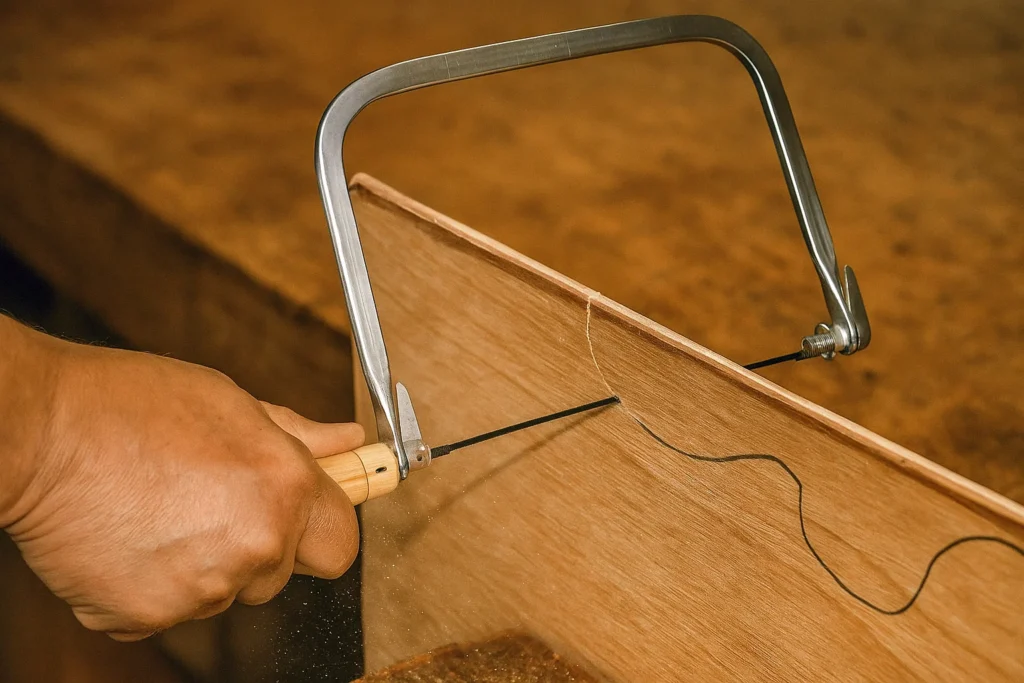
Choosing a curved-cut hand saw isn’t just about specs, it’s about what you’re trying to do.
Different projects need different types of curves, and each saw has strengths that fit certain situations better than others. This section helps you match your goal with the right tool.
Even if two saws can technically “cut a curve,” they won’t give you the same results. One may handle fine detail better, while another is more suitable for cutting through thicker material or making long sweeping curves.
Below are the most common curved-cut tasks and the saws best suited for them.
Use Case 1: Scrollwork, Decorative Cuts, and Tight Detail
Best saw: Fret saw
If you’re working on fine patterns, inlays, or puzzle-like shapes where precision is critical and curves are very tight, you need a fret saw. Its extremely thin blade allows sharp turns with minimal waste.
Avoid coping saws here, they’re slightly bulkier and may not handle ultra-tight turns as cleanly.
Use Case 2: General Wood Shaping or Furniture Work
Best saw: Coping saw
When shaping curved edges on table legs, arms of chairs, or any furniture pieces, a coping saw gives you the right balance of control, strength, and curve-following ability. It’s also handy for cutting moldings and joints that require curved edges.
It’s ideal for moderate curves, tight enough to shape, loose enough to avoid stress on the blade.
Use Case 3: Large Curves in Thick Material
Best saw: Bow saw
If you’re cutting large arcs in thick slabs of wood (like for benches, arches, or live edge projects), a bow saw gives you the reach and strength to power through.
Its blade isn’t as narrow as a fret or coping saw, but it’s strong and sharp enough for rougher, wider-radius curves.
Don’t use fret or coping saws here, they’ll struggle with depth and likely break under pressure.
Use Case 4: Internal Curves (Plunge Cuts in the Middle of a Panel)
Best saw: Keyhole or compass saw
If the curve doesn’t start from an edge—like a hole in the center of plywood or drywall—you’ll need to drill a starter hole, insert the blade, and cut outwards. A keyhole saw is built exactly for this.
Coping and fret saws require blade removal to do plunge cuts, which is slower and more difficult, especially for beginners.
Use Case 5: Gentle Curves in Trim or Thin Stock
Best saw: Flexible Japanese pull saw
If you’re shaping small, shallow curves on thin trim, veneers, or softwood, some pull saws with flexible blades offer a cleaner, smoother result than other saw types.
They’re especially useful when looks matter and the cut needs to be clean right off the saw.
Note: Not ideal for tight curves, they work best when the bend is slow and smooth.
Common Mistakes (And How to Avoid Them)
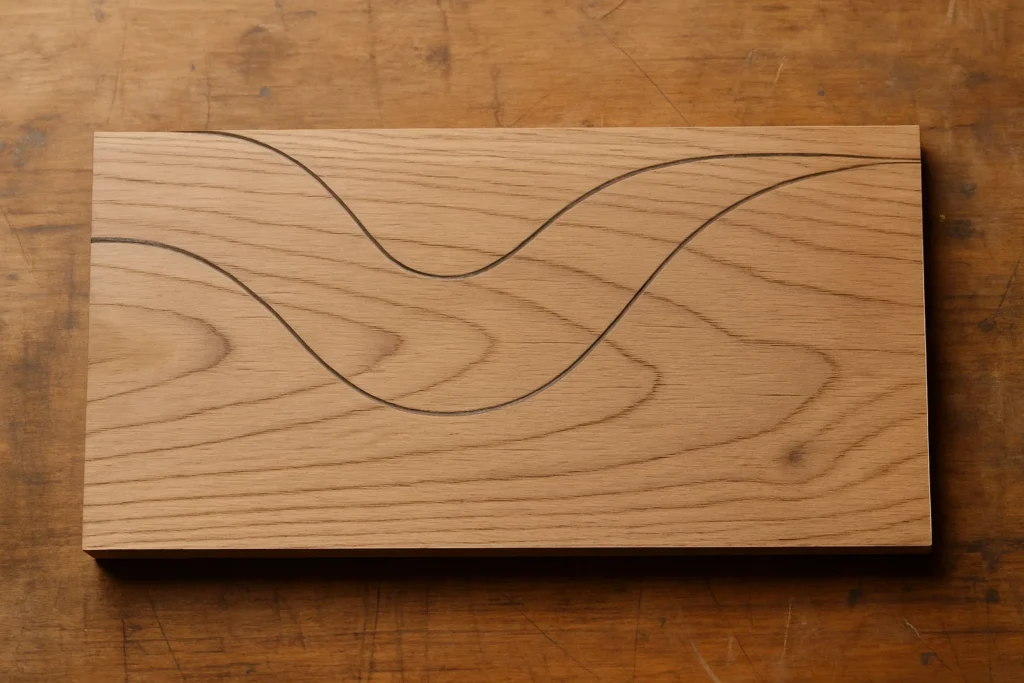
Even with the right saw, using it the wrong way—or picking the wrong version for your specific curve—can lead to frustration, wasted materials, or even broken tools.
Most of these mistakes are easy to avoid once you know what to watch for.
Mistake 1: Choosing a Blade That’s Too Wide for the Curve
A wider blade makes turning harder. This can lead to jagged edges, splintered material, or even a snapped blade.
If you’re cutting a tight or complex curve, always check the blade width first. Forcing a wide blade into a tight turn rarely ends well.
Use thinner blades for tighter turns. Coping and fret saws are safer bets than bow or keyhole saws for detailed curves.
Mistake 2: Prioritizing Speed Over Control
It’s tempting to rush through a cut, especially with aggressive teeth or a larger saw. But speed often sacrifices accuracy, and once you veer off line, there’s no fixing it without starting over.
Let the saw do the work. Use steady, light pressure. Focus on staying on the line, not finishing fast.
Mistake 3: Using a Straight-Cut Saw for Curves
Some users grab whatever saw is nearby and try to “make it work.” Straight-cut saws—like traditional handsaws or crosscut saws—aren’t meant for turning. They fight the curve and leave rough or broken edges.
Use saws designed for curves only. Even flexible pull saws only work for gentle bends, don’t push them beyond their limits.
Mistake 4: Ignoring Handle Comfort and Control
A poorly designed or uncomfortable handle leads to hand fatigue and poor results. If your grip shifts mid-cut or your wrist feels strained, the saw isn’t working with you.
Choose a handle that fits your grip and allows steady movement. A good handle improves accuracy without you having to overthink it.
Mistake 5: Overlooking Blade Tension (When It Matters)
Some saws, like coping and fret saws, rely on blade tension. If the tension is too loose, the blade will bend or wander. Too tight, and the blade could snap under pressure.
Learn how to adjust blade tension properly. It should be tight enough to stay straight when pushed, but not overly stiff. A slight “ping” sound when plucked is often a good sign.
Tips for Cleaner, More Accurate Curved Cuts
- Drill a starter hole for internal cuts – Always drill a hole slightly wider than your blade to make clean plunge starts, especially when using coping, fret, or keyhole saws.
- Practice on scrap material first – Test your curve on a similar scrap piece to get a feel for blade control, pressure, and turn radius before cutting your actual workpiece.
- Use your whole arm, not just your wrist – Move your elbow and shoulder with the cut to keep strokes smooth and avoid shaky, uneven curves.
- Let the blade do the work – Apply light, steady pressure; forcing the blade can lead to flexing, jamming, or snapping, especially with fine-tooth saws.
- Stop and realign if you drift off line – If the blade starts to wander, pause, back up slightly, and correct, never try to force it back on track mid-stroke.
Final Thoughts
In sum, mastering curved cuts means matching your project to the right saw.
Whether a fret saw for tight scrollwork, a coping saw for general shaping, a bow saw for large arcs, a keyhole saw for plunge cuts, or a flexible pull saw for gentle bends.
Look for a narrow blade (under 1/8″) with 15–20 TPI, balanced flex, a comfortable handle, and proper tension.
Armed with the right tool and light, steady strokes—plus a quick test on scrap—you’ll achieve clean, precise curves every time. What’s your next curved‑cut challenge?
This lightweight fret saw offers fast tensioning, ambidextrous setup, and precise curved cuts for frequent users. Its premium price and minor clamp quirks may deter casual hobbyists.
If you see any kind of mistake in our content, make sure to reach out to us.
Frequently Asked Questions (FAQs)
What saw is best for cutting curves?
For general curves, a coping saw offers the best balance of control and blade flexibility.
Use a fret saw for very tight or intricate scrollwork, a bow saw for large sweeping arcs in thicker stock, a keyhole (compass) saw for internal plunge cuts, and a thin Japanese pull saw for gentle, clean curves in trim or veneers.
How to cut a perfect curve?
- Mark your line: Draw the curve clearly on your workpiece.
- Secure the workpiece: Clamp it firmly to prevent movement.
- Drill starter hole (if needed): For internal curves, drill a hole slightly larger than your blade.
- Use light, steady strokes: Let the blade advance at its own pace with minimal pressure.
- Rotate the workpiece, not the saw: Pivot the stock as you cut to maintain a smooth arc.
- Follow the line and back up if you drift: Ease the blade back out, realign, then continue.
- Finish by sanding: Refine the edge with a sanding block or drum sander.
Can I cut a curve with a circular saw?
You can make very gentle, large‑radius curves by freehanding a circular saw along a guide, but it’s prone to tear‑out and limited by blade depth.
For tighter or more precise curves, a handheld jigsaw or a fine‑tooth handsaw is a better choice.
Can a reciprocating saw cut curves?
A reciprocating saw can rough‑cut broad curves or openings, especially in demolition or framing, but its coarse, vibrating action limits precision.
Use a narrow, fine‑tooth pruning or demo blade and steady motion for smoother results, then clean up the edge with a finer tool.
The Grain Bros was started to serve woodworkers who can’t find products for their specific use case. We found out that there are not many media outlets extensively covering this topic. That’s why, we are here, to do the research and find the perfect products for your next DIY project. So you don’t have to juggle your tools and laptop at the same time.
If you see any kind of mistake in our content, make sure to reach out to us.

